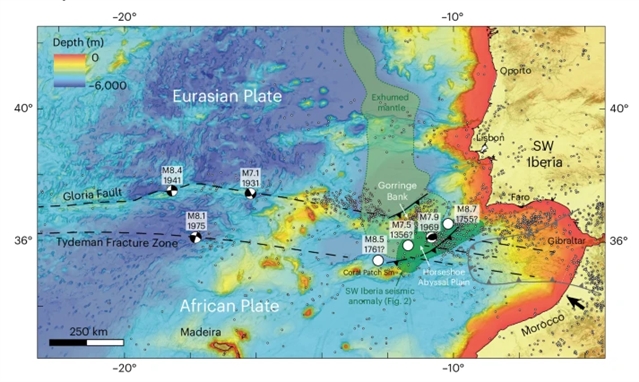
近日,葡萄牙里斯本大学João C. Duarte团队研究了伊比利亚西南部近海海洋板块剥离的地震证据。这一研究成果于2025年8月27日发表在《自然—地球科学》杂志上。
海洋岩石圈的俯冲作用和大陆岩石圈的剥离作用构成了地球表面再循环进入地幔的两种主要机制。大陆板块剥离通常发生在碰撞造山带,这是由于岩石圈地幔与上覆较轻的地壳分离,并在大陆岩石圈内弱层的辅助下发生的。相比之下,海洋岩石圈通常被认为具有足够的刚性以抑制分层。
通过地震成像和数值模拟表明,伊比利亚西南部近海发生了海洋岩石圈的分层。具体来说,地震层析成像揭示了一个高速异常,研究组将其解释为旧海洋岩石圈的剥离块,他们用数值模拟再现了这一过程。研究组认为,这一过程是由板块汇聚引发的,并有一层厚厚的蛇纹石层辅助,使岩石圈地幔与上覆的地幔分离。研究组认为,这种海洋剥离可能促进了板块构造理论中长期未解决的问题——俯冲起始,并可能是欧洲一些最高震级地震的原因,包括1755年的8.5-8.7级里斯本大地震和1969年的7.9级圣文森特地震。
附:英文原文
Title: Seismic evidence for oceanic plate delamination offshore Southwest Iberia
Author: Duarte, Joo C., Riel, Nicolas, Civiero, Chiara, Silva, Snia, Rosas, Filipe M., Schellart, Wouter P., Almeida, Jaime, Terrinha, Pedro, Ribeiro, Antnio
Issue&Volume: 2025-08-27
Abstract: Subduction of oceanic lithosphere and delamination of continental lithosphere constitute the two predominant mechanisms by which the Earth’s surface is recycled into the mantle. Continental plate delamination typically occurs in collisional orogens by the separation of the lithospheric mantle from the overlying lighter crust, aided by weak layers within continental lithosphere. By contrast, oceanic lithosphere is generally considered to be sufficiently rigid to inhibit delamination. Here we show from seismic imaging and numerical simulations that delamination of oceanic lithosphere is occurring offshore Southwest Iberia. Specifically, seismic tomography reveals a high-velocity anomaly that we interpret as a delaminating block of old oceanic lithosphere, a process that we reproduce with numerical simulations. We propose that this process was triggered by plate convergence and assisted by a thick serpentinized layer that allows the lithospheric mantle to decouple from the overlying crust. We suggest that such oceanic delamination may facilitate subduction initiation, a long-unsolved problem in the theory of plate tectonics, and may be responsible for some of the highest-magnitude earthquakes in Europe, including the M8.5–8.7 Great Lisbon Earthquake of 1755 and the M7.9 San Vincente Earthquake of 1969.
DOI: 10.1038/s41561-025-01781-6
Source: https://www.nature.com/articles/s41561-025-01781-6
